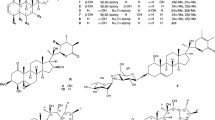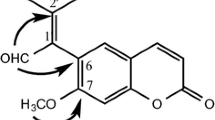Abstract
Adult T-cell leukemia/lymphoma (ATL) is a malignancy of mature peripheral T lymphocytes caused by human T-cell lymphotropic virus type 1 (HTLV-1). There are an estimated 5 million to 20 million HTLV-1-infected individuals worldwide; their lifetime risk of developing ATL is 3–5 %, and high HTLV-1 proviral loads have been shown to be an independent risk factor. Although conventional chemotherapeutic regimens used against other malignant lymphomas have been administered to ATL patients, the prognosis is often poor. In previous studies, we screened 459 extracts from 344 plants to isolate components exhibiting antiproliferative activity against HTLV-1-infected T-cell lines (MT-1 and MT-2). In our continuing search for potential anti-HTLV-1 natural products, 15 extracts of Asclepiadaceae plants were further tested against MT-1 and MT-2 cells. The MeOH extract of aerial parts of Tylophora tanakae showed antiproliferative activity. Activity-guided fractionation resulted in the isolation of 6 phenanthroindolizidine alkaloids (including a new compound), and we examined their antiproliferative activity against MT-1 and MT-2 cells. The EC50 value of some of the alkaloids was in the low nanomolar range, comparable to that of the clinically used antineoplastic drug doxorubicin. Structure–activity relationship analyses suggested that a 14β-hydroxy moiety is essential for activity against HTLV-1-infected T cells. In contrast, the presence of a 2-methoxy moiety, a 7-methoxy moiety, or an N-oxide moiety appears to reduce the potency of the antiproliferative activity against HTLV-1-infected T cells.



Similar content being viewed by others
References
Ishitsuka K, Tamura K (2008) Treatment of adult T cell leukemia/lymphoma : past, present, and future. Eur J Haematol 80:185–196
Yamamoto K, Utsunomiya A, Tobinai K, Tsukasaki K, Uike N, Uozumi K, Yamaguchi K, Yamada Y, Hanada S, Tamura K, Nakamura S, Inagaki H, Ohshima K, Kiyoi H, Ishida T, Matsushima K, Akinaga S, Ogura M, Tomonaga M, Ueda RJ (2010) Phase I study of KW-0761, a defucosylated humanized anti-CCR4 antibody, in relapsed patients with adult T cell leukemia-lymphoma and peripheral T cell lymphoma. Clin Oncol 28:1591–1598
Nakano D, Ishitsuka K, Hatsuse T, Tsuchihashi R, Okawa M, Okabe H, Tamura K, Kinjo J (2011) Screening of promising chemotherapeutic candidates against human adult T cell leukemia/lymphoma from plants: active principles structure–activity relationships with withanolides. J Nat Med 65:559–567
Nakano D, Ishitsuka K, Katsuya H, Kunami N, Nogami R, Yoshimura Y, Matsuda M, Kamikawa M, Tsuchihashi R, Okawa M, Ikeda T, Nohara T, Tamura K, Kinjo J (2012) Screening of promising chemotherapeutic candidates from plants against human adult T cell leukemia/lymphoma (II): apoptosis of antiproliferactive principle (24,25-dihydrowithanolide D) against ATL cell lines and structure–activity relationships with withanolides isolated from solanaceous plants. J Nat Med 66:415–420
Abe F, Iwase Y, Yamauchi T, Honda K, Hayashi N (1995) Phenanthroindolizine alkaloids from Tylophora tanakae. Phytochemistry 39:695–699
Abe F, Hirokawa M, Yamauchi T, Honda K, Hayashi N, Ishii M, Imagawa S, Iwahana M (1998) Further investigation of phenanthroindolizine alkaloids from Tylophora tanakae. Chem Pharm Bull 46:767–769
Ikeda T, Yaegashi T, Matsuzaki T, Yamazaki R, Hashimoto S, Sawada S (2011) Synthesis of phenanthroindolizidine alkaloids and evaluation of their antitumor activities and toxicities. Bioorg Med Chem Lett 21:5978–5981
Dan S, Anne KL, Jette C, Boadan AB, Abe F, Jerzy WJ (2002) In vitro cytotoxic activity of phenanthroindolizidine alkaloids from Cynanchum vincetoxicum and Tylophora tanakae against drug-sensitive and multidrug-resistant cancer cells. J Nat Prod 65:1299–1302
Rao KN, Venkatachalam SR (2000) Inhibition of dihydrofolate reductase and cell growth activity by the phenanthroindolizidine alkaloids pergularinine and tylophorinidine: the in vitro cytotoxicity of these plant alkaloids and their potential as antimicrobial and anticancer agents. Toxicol In Vitro 14:53–59
Acknowledgments
We thank the Kashihara City Insectarium (Nara, Japan) for providing the aerial parts of Tylophora tanakae plants.
Author information
Authors and Affiliations
Corresponding author
Rights and permissions
About this article
Cite this article
Nakano, D., Ishitsuka, K., Ikeda, M. et al. Screening of promising chemotherapeutic candidates from plants against human adult T-cell leukemia/lymphoma (IV): phenanthroindolizidine alkaloids from Tylophora tanakae leaves. J Nat Med 69, 397–401 (2015). https://doi.org/10.1007/s11418-015-0906-8
Received:
Accepted:
Published:
Issue Date:
DOI: https://doi.org/10.1007/s11418-015-0906-8




